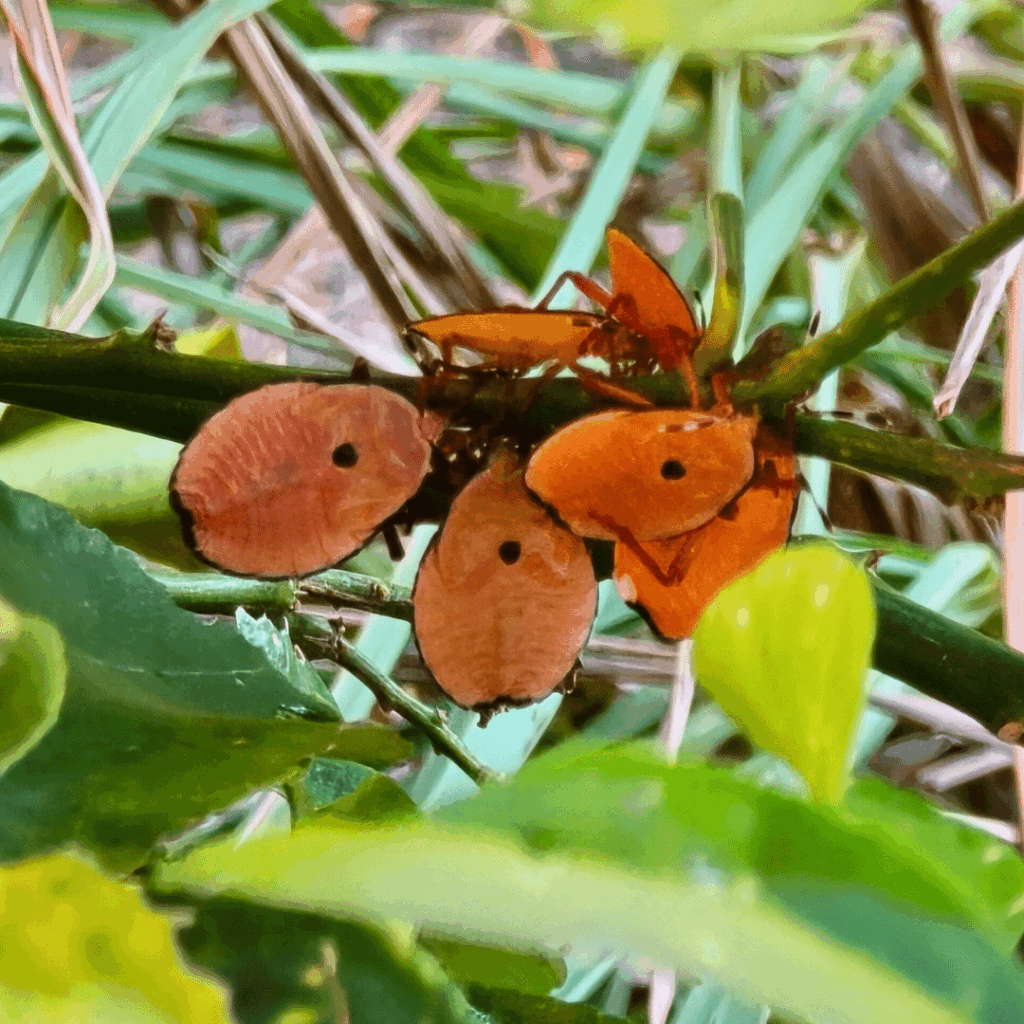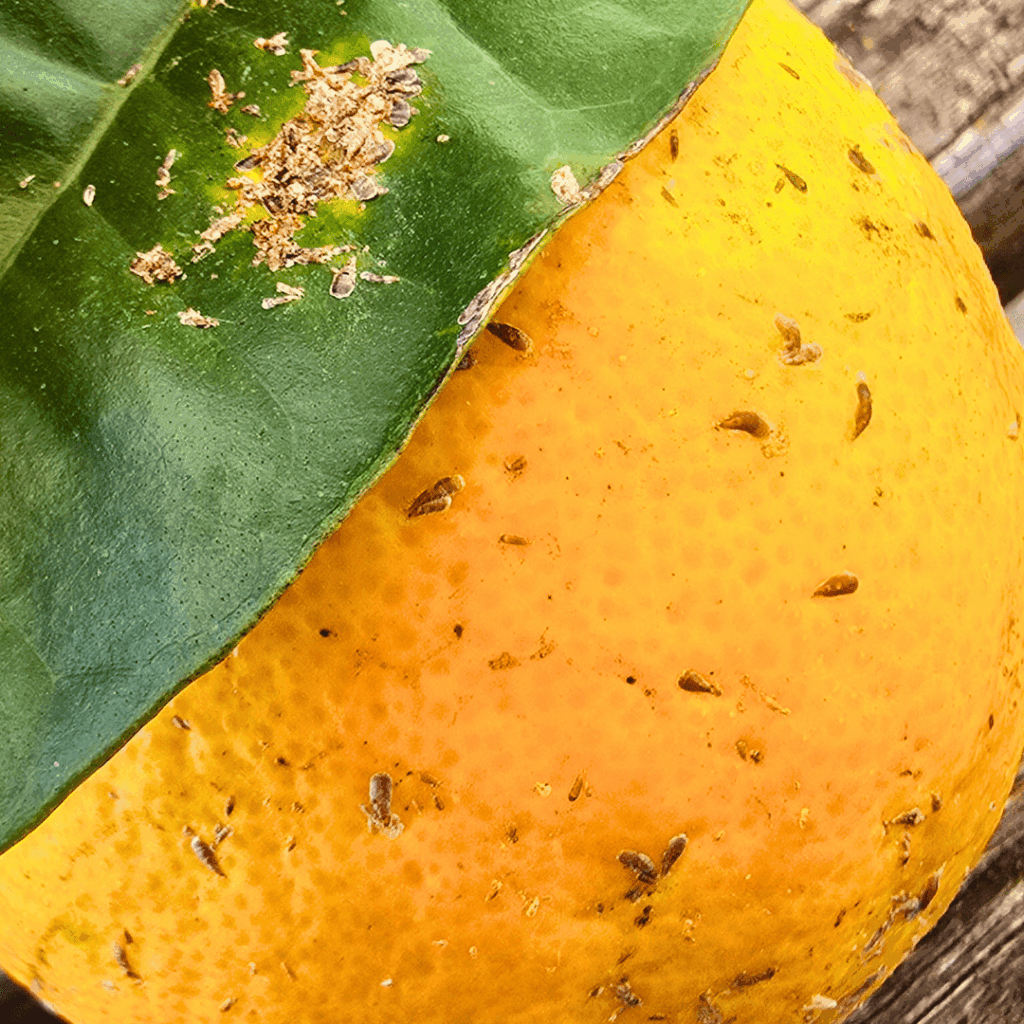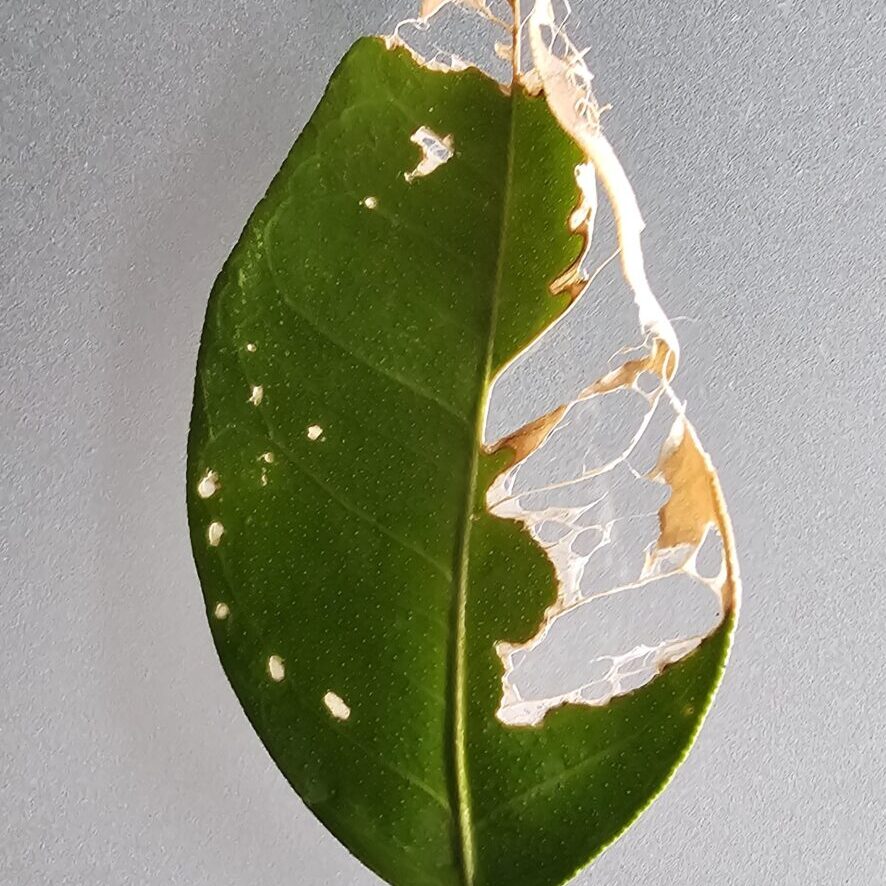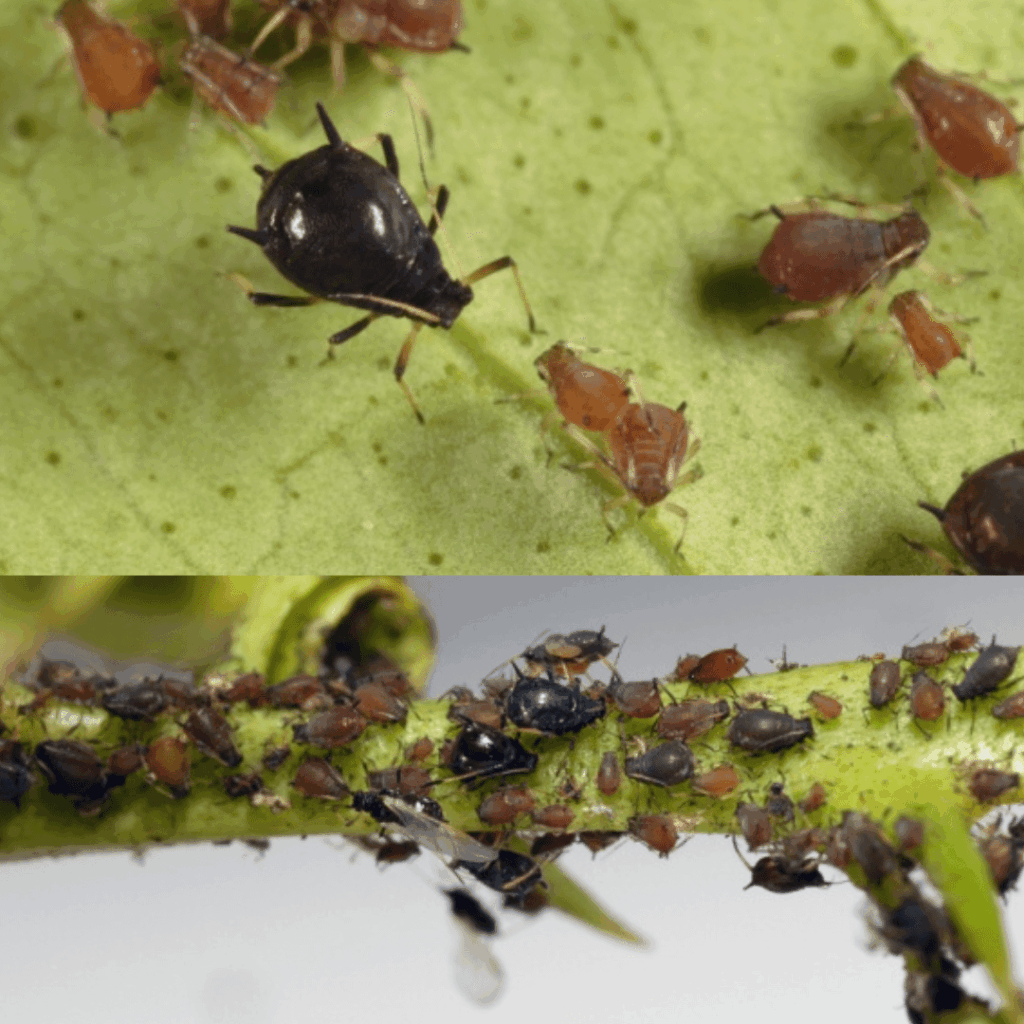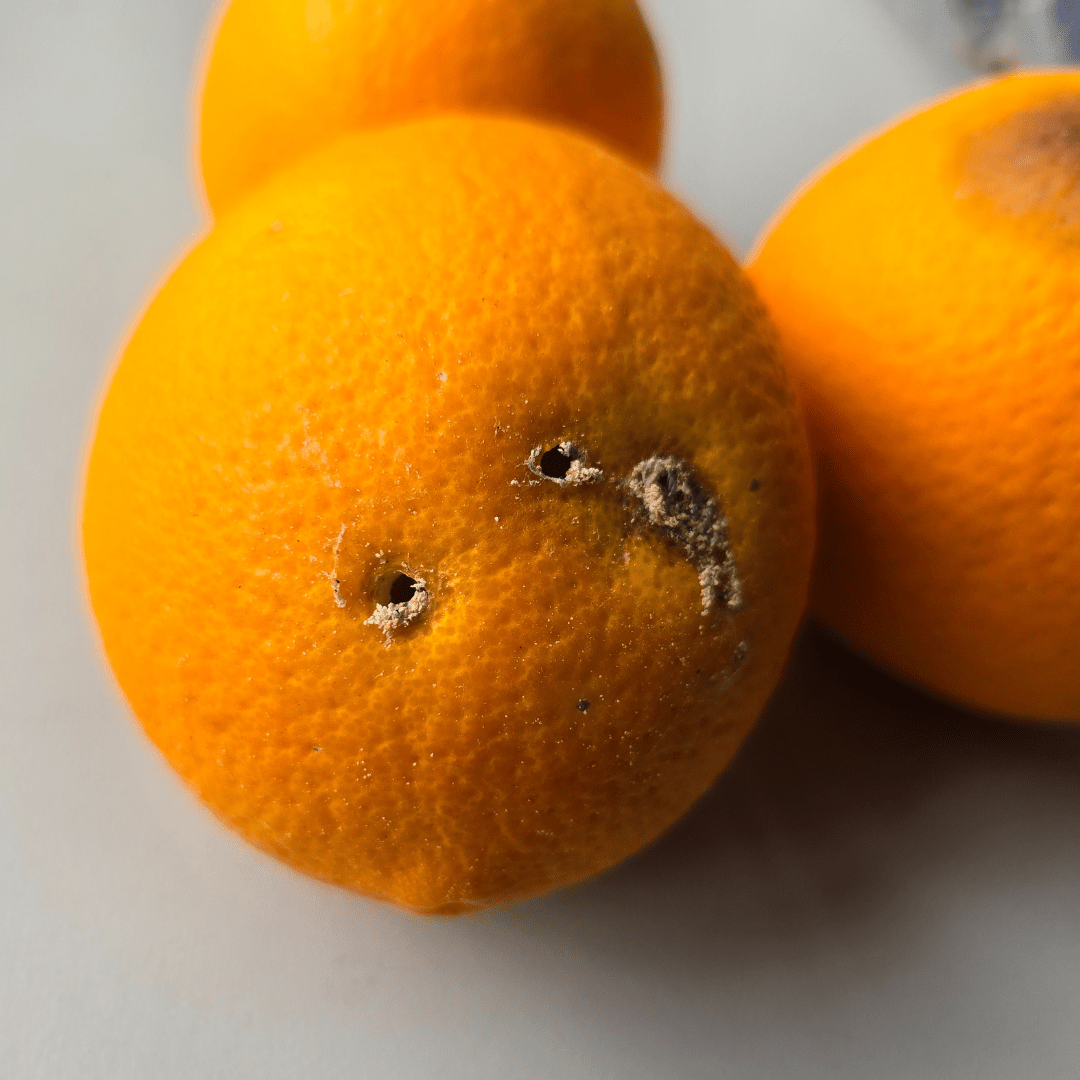Citrus Pests
The Usual Suspects
Citrus trees, much like many other plants, can be the unfortunate victim of pest attacks. We’ve gathered the most common little buggers below with information about each and, most importantly, what you can do about them.
Click on a pest to jump straight to that section or keep scrolling to read through them all.

Citrus Leaf Miner
What are they?
Probably the most common citrus pest, leaf miner is a small nocturnal moth that lays its eggs on the underside of new leaves.
On established trees, leaf miner isn’t a particularly major threat. However, on young trees, taking preventative measures is your best bet as they can severely stunt your tree’s growth.
What do they do?
Once an adult leaf miner moth lays its eggs in a citrus leaf, they’ll eventually hatch into tiny grubs that mine their way through the leaf.
This is what causes that silvery damage trail which eventually fades to brown and distorts your leaves, resulting in a bit of leaf curl.
Once the larvae mature, they curl the leaf edges over themselves and form a cocoon. After that, they hatch and become adult moths, and the leaf miner cycle begins again.
Leaf miner won’t usually cause a tree to die, unless it’s a very young tree and an extremely major and uncontrolled infestation.
It also doesn’t affect the fruit; it only distorts the new leaf growth.
How do I fix this?!
Once the damage is done, it can’t be repaired. Trim off the damaged leaves and dispose of them carefully, just in case there are any larvae or cocoons left over.
Spraying trees with ‘Eco-Oil’ or ‘Eco-Neem’ every 2 weeks during “leaf miner season” can help control outbreaks. These two products can actually be mixed together in the same sprayer and used simultaneously for additional protection.
At times, you may need to alternate products into your care routine to ensure better coverage and control. Some other products we use are Yates Success Ultra Insect Control or Yates Nature’s Way Citrus & Ornamental Spray.
As always, when using any products in the garden, be certain to read the instructions and bio-safety information to understand what you’re using and if it’s right for your garden.

Stink Bugs
What are they?
Stink bugs, also known as the ‘Bronze Orange bug’, are a multi-stage insect that are native pests of citrus trees. They start their lives as small green insects before maturing into the typically orange or bronze shield-shaped insects we usually see on our trees.
What do they do?
Stink bugs lay their eggs around late spring to early summer. Once those hatch, the first stage insects don’t actually feed on the tree, so this is a great time to remove them. Most of the damage is done by the late-stage nymphs or adult insects.
Once they start feeding, they suck the sap out of new growth causing it to wither and die. They also attack flower stalks and budding fruit, causing those to drop off as well.
A few of these insects can decimate younger trees, and whole infestations can do significant damage even to established trees.
As the name implies, the insects have an unpleasant smell. They secrete a foul acid as their main defense mechanism which can be harmful to skin and eyes.
How do I fix this?!
Prevention is the best defense with stink bugs. Keep an eye out for their eggs on the underside of leaves in late spring-early summer and remove them before they hatch.
You can use an insecticide like Yates Success Ultra Insect Control or Nature’s Way Citrus & Ornamental Spray by Yates as part of your citrus care regime. They often work on the younger stages of these insects, so getting in early and creating a pest control routine will be most effective against stink bugs in the long run.
Since the adults are notoriously difficult to control, in conjunction with spraying, we recommend physical removal.
There are a few ways you can do this, but our favourite method is to use an old vacuum cleaner to suck up the insects. You can then empty the vacuum into a bucket of hot, soapy water to destroy them. You can also use extra-long BBQ tongs to pick the stink bugs off if you prefer.
You can often find them on really hot days when they hide on the underside of leaves to stay cool.
As always, use caution and wear protective gear when removing stink bugs! They spray a defensive acid when predators get too close, and you definitely don’t want it on your skin or in your eyes as it can be quite damaging.
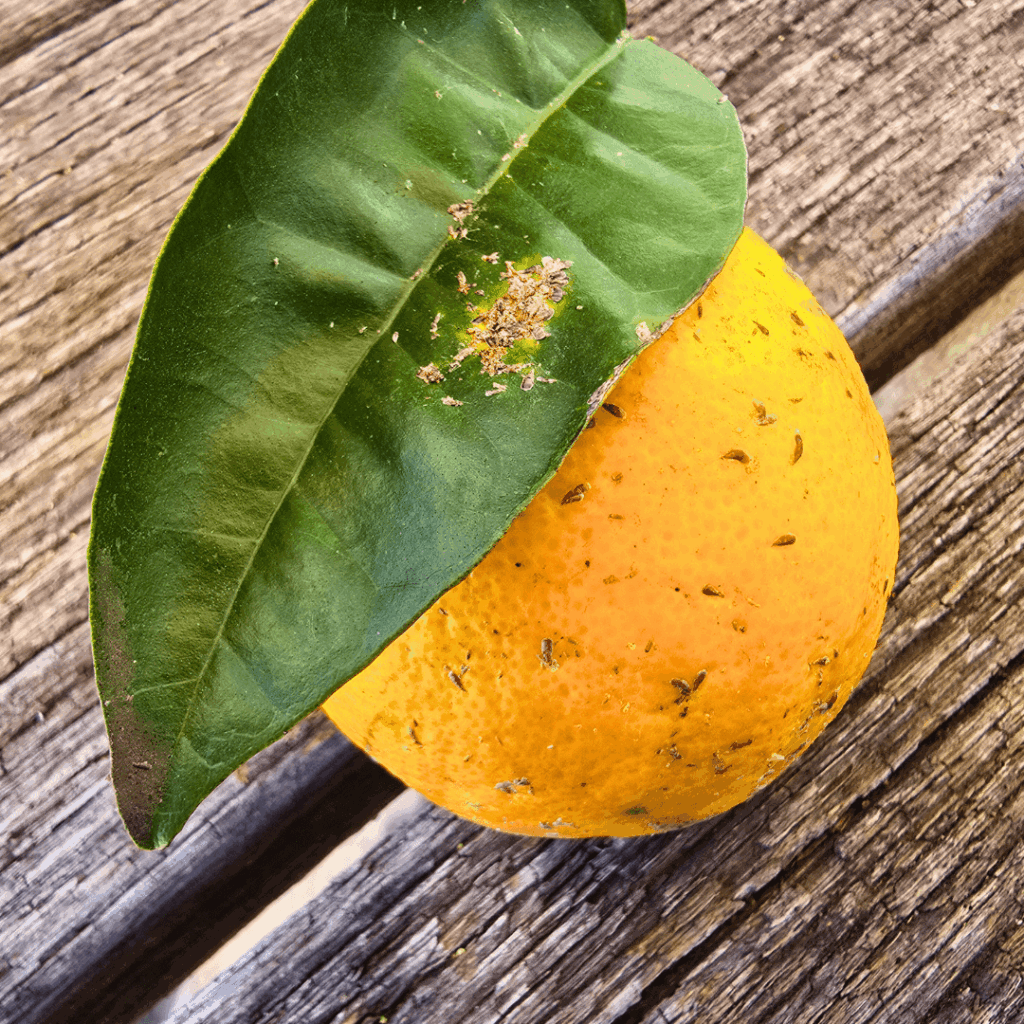
Scale
What are they?
Scale insects come in many different shapes and sizes. They can be as small as 1-2mm, round and dome-shaped or flat and oval. Some are even up to 1cm long and look like a fluffy, white pillow (these are aptly called Cottony Cushion Scale).
Something to note that may help in your identifications, there are two main types of scale: Hard scale and Soft scale. Below are some that typically affect citrus trees.
Hard Scale Types
- Red Scale
- White Louse Scale
Soft Scale Types
- White or Pink Wax Scale
- Black Scale
- Soft Brown Scale
What do they do?
Scale insects attack most parts of a tree, from the stems and trunk (White Louse Scale) to both the leaves and fruit (Red Scale).
Soft Scales attach to your tree and leech the nutrients from the cambium layer. Their eating habits produce large amounts of honeydew (a sweet, sappy substance), which ants love to take advantage of. This usually leads to Sooty Mould forming as the ants track the honeydew all over the leaves and tree.
Hard Scales don’t produce much honeydew, but they can blemish fruit and leaves. Often, if you scrape a hard scale off a leaf or fruit, you’ll see a lighter or unripe spot underneath, kind of like a tan-line. Large populations of hard scale on the leaves can cause leaf drop.
High populations of either scale type can cause severe damage, stunted growth, or even the death of trees depending on the type of scale, so it’s important to act quickly if you see them.
How do I fix this?!
It’s always a good idea to maintain pest treatments like ‘Eco-Oil’ or ‘Eco-Neem’ on a regular basis. Scale also does not like sunlight, so keeping good airflow by regularly trimming the inner branches and removing any dead wood to open up the canopy and expose scale to sunlight will work very nicely when paired with regular pest treatment.
Yates Success Ultra Insect Control or Yates Nature’s Way Citrus & Ornamental Spray are also good options.
As always, read all product labels carefully when deciding which are suitable for your garden.

Caterpillars
What are they?
Caterpillars are well known for being the larval stage of butterflies or moths. They’re also well known for being a constant thorn in many a gardener’s thumb, munching on most things in the garden. Unfortunately, citrus trees are no exception.
They vary greatly in size, shape, and colour depending on which insect laid their eggs on your tree. You might see anything from black or brown, to green with colourful stripes, spots, or little fleshy spines on their bodies. Some even look like young new branches, so you’ll need a keen eye to spot them.
What do they do?
They are one of the causes of large irregular holes you might see in your citrus leaves. This might be in the middle or even starting from the edge of your leaves, caterpillars aren’t picky eaters.
We will note, of course, that some of these caterpillars turn into lovely large citrus butterflies and a few chewed leaves are not going to kill the tree.
How do I fix this?!
A keen-eyed gardener can use good old fashioned hand removal, especially if trying to reduce usage of pest products. Alternatively, you can use naturally derived remedies like plant-based dish soap dilutions, or specific products like ‘Eco-Oil’ or ‘Eco-Neem’ every 10 -14 days as a deterrent.
As always, read all product labels carefully when deciding which are suitable for your garden.

Snails & Slugs
What are they?
The common garden snail probably needs no introduction and the same can be said for slugs. You may not actually spot these pests as they prefer to lurk in dark, damp places out of the sun. Luckily, they do leave behind a very incriminating slime trail on both your leaves, bark, and soil that can help confirm any suspicions they might be hanging around your citrus trees.
What do they do?
They both cause pretty extensive damage to both the leaves and fruit of citrus, especially oranges.
They start by attacking the soft, new leaf growth by chewing holes in them, often creating a skeletonised looking leaf, with only the leaf veins left behind.
As your fruit begins to ripen, they can also attack the skin, chewing right through to the inner flesh of the fruit.
How do I fix this?!
These pests can be relatively well controlled by using snail bait around your yard. Eco-Shield is one option. It’s safe to use around your fruit and vegetables, though you should be mindful if you have pets or young children as it can be harmful if consumed.
NOTE: Always read the details and instructions to determine if a product like this is right for your yard.
Other deterrents include reducing the places snails like to hide. Tall or thick weeds, old leaf matter, thick damp mulch, etc.
Homemade beer traps also work very well for smaller snail and slug populations (as well as a host of other insects). Either share the dregs of your VB with these critters straight from the bottle or place some in shallow containers around your yard so they can have a big weekend.
Alternatively, you can try creating barriers made of different materials around your garden or your citrus trees. Things like diatomaceous earth, crushed eggshells, lime. You can even put copper tape around the tree.
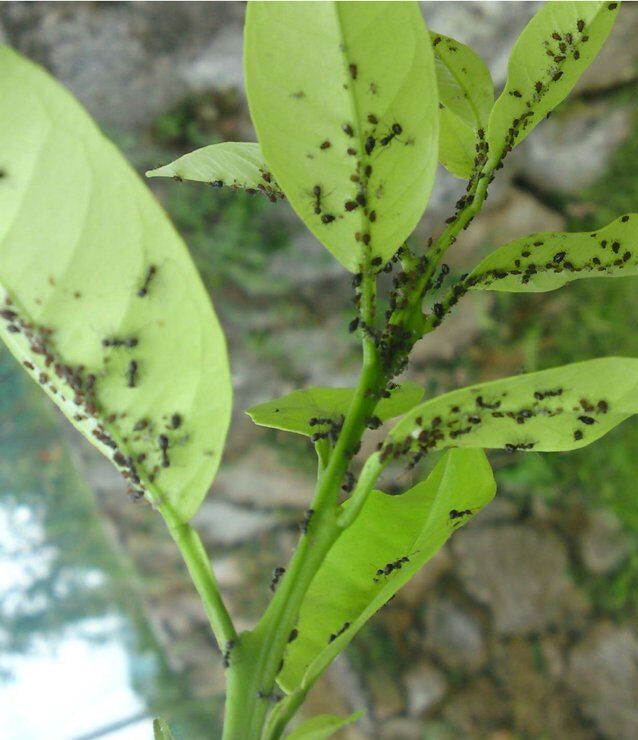
Aphids
What are they?
Aphids come in many different shapes and sizes and attack more than just citrus, of course. Some will be green or a shiny black or brown, some have wings, while others don’t. They’re all quite small, and they come in droves. They take the term ‘bring your friends’ very seriously. Infestations can happen suddenly, as they fly in and reproduce relatively quickly.
What do they do?
Aphids can attack in plague like proportions, with literally thousands gathering on the ends of new shoots.
Since they’re a sap sucking insect, rather than finding big bite marks, you’ll most likely notice little disoloured dots on your leaves or wilting new growth and stems. Their eating habit often results in distorted, curled leaves and stunted growth. They can even cause new growth dieback, especially with larger infestations.
They’re messy eaters, so their feeding also leaves behind honeydew which can cause the secondary issue of attracting ants and causing sooty mould.
How do I fix this?!
Happily, aphids are relatively easy to spot since there’s usually so many of them and they aren’t so tiny as to go unnoticed. The safest control options would be things like ‘Eco-Oil’ or ‘Eco-Neem’ or other pyrethrum-based sprays. Using these every 10 -14 days can work as both control and deterrent.
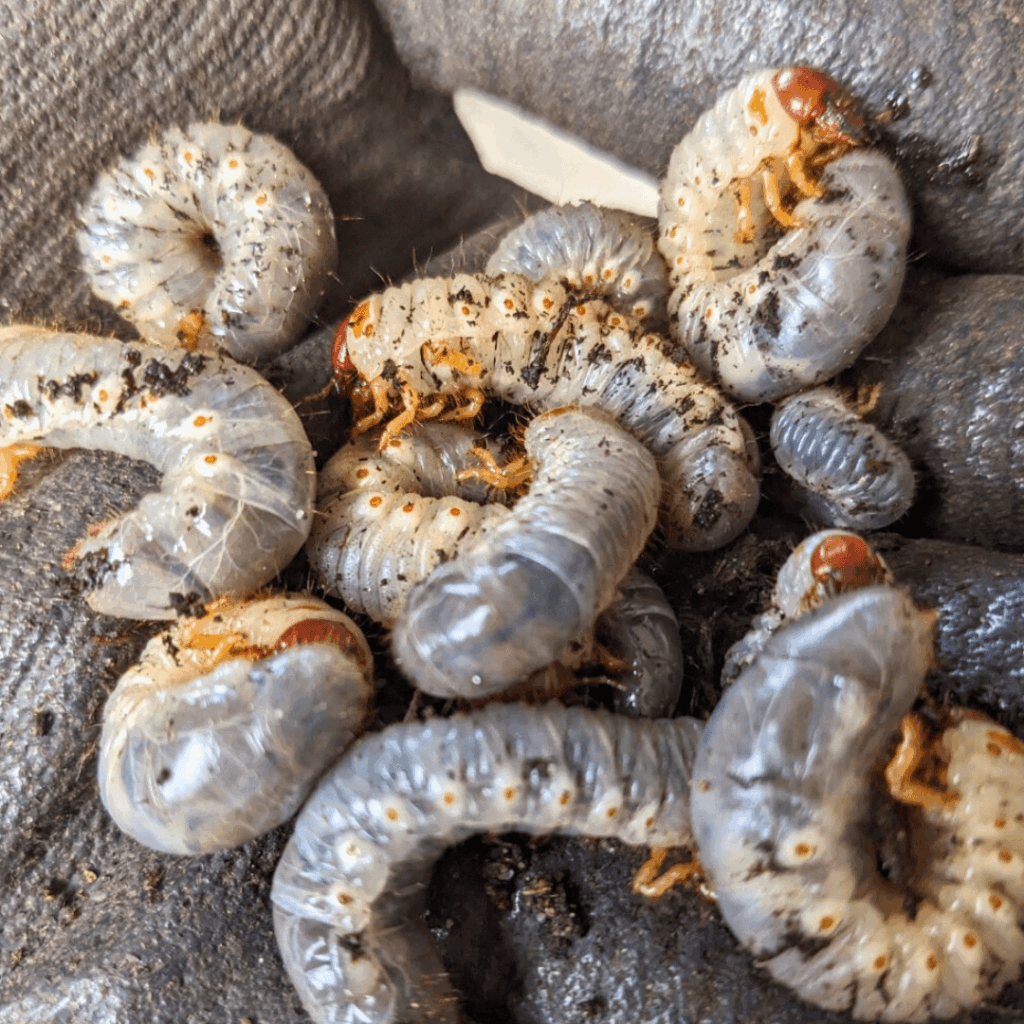
Curl Grubs
What are they?
Curl grubs are pretty awful to look at, huh? They come in slightly different shades, but are typically white or sort of translucent, with an orange or brown head. They can be quite chunky and are usually about 2-5cm long, but often they’ll be all curled up in a ‘C’ shape, which is where they get their name.
Curl grubs are the larvae of different beetle varieties, including (but not limited to) the African Black Beetle or even the familiar old Christmas Beetle.
What do they do?
The beetles land in the soil and deposit their eggs on the roots of trees, shrubs, or even just beneath your lawn surface. In time, those eggs hatch and the young larvae begin to feed on the root systems until they grow nice and big.
Depending on the number of grubs present, they can totally devastate a young tree very quickly. Even mature trees with bigger root systems are at risk and will show very clear signs of distress.
There’s no real easy way to guess if these grubs are on your tree until it’s a little too late. They can be in both the ground or in pots, too. They don’t tend to spread from tree to tree, thankfully.
Assuming everything else is being done to the tree’s liking (feeding, watering, regular pest sprays, etc), if you notice a relatively sudden decline, it could be time to check for these little pests. Look for signs like drooping, discolouring, or falling leaves. Or if your tree is not growing much at all, it may be a sign that curl grubs have made a meal of its roots.
How do I fix this?!
Unfortunately, since the beetle eggs are below the soil surface, they’re nearly impossible to spot until they turn into grubs and start doing damage. During heavy rains, grubs may surface for relief from excess water, so it’s a good habit to run out there and check the ground after some rain, especially if your tree is struggling.
You can mimic this by flooding your tree with the garden hose to try and draw grubs to the surface. The local birds will make quick work of them. They make a great peace offering to the magpies, we’ll say that much.
One of the best treatments for curl or lawn grubs is an ‘Eco-Neem’ soil drench. 2 – 3 treatments should be enough to do the trick, as the water will bring grubs to the surface, and the Eco-Neem will penetrate and destroy the eggs. A similar effect can be achieved with some heavily diluted soapy water, though the soap may not kill the eggs, so it may need to be done more regularly.
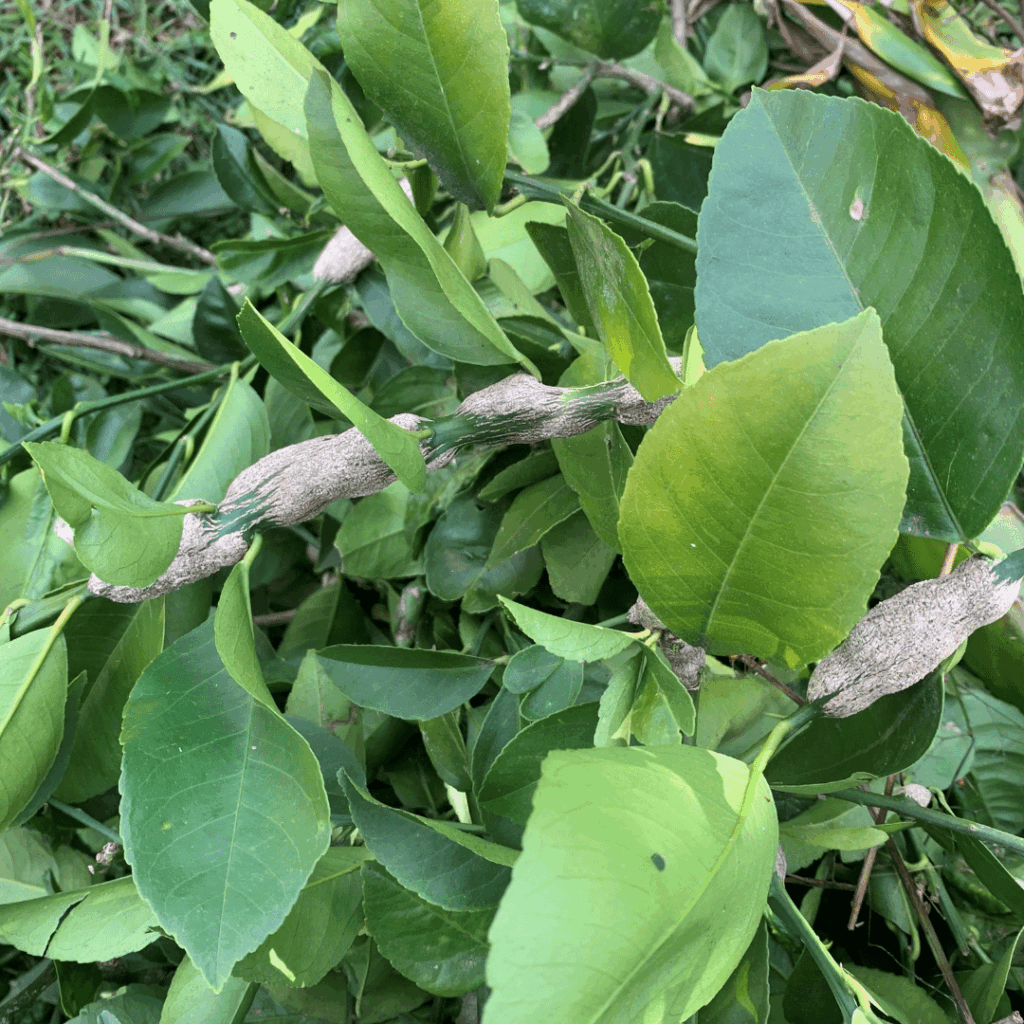
Citrus Gall Wasp
What are they?
Citrus Gall Wasps are actually (unfortunately) a native insect. Their predominant host was the Australian Finger Lime, though they’ve since developed a taste for most other citrus, grafted or otherwise. These guys are pretty tiny at just 2 – 3mm long, almost resembling ants from a distance. You might not spot the bugs themselves, unless there’s a big infestation, but you’ll definitely notice the damage they do.
What do they do?
At just 3 – 14 days, adult gall wasps have a short life span, so they do a lot of work during that time. Female wasps can lay up to 100 eggs under the bark of citrus branches, resulting in those woody lumps or galls that form around the larvae. Within those galls, the larvae take about 8 – 10 months to fully transform before they emerge.
Adults can emerge from around September – October, depending on weather and lay eggs usually within the first 3 days of their lives. November -January is when you might be able to notice the first signs of galls appearing. They’ll be much smaller then, so it’s a good time to catch it. On emergence, you’ll see tiny holes in the galls, like they’ve been finely drilled through.
The galls themselves affect the tree’s ability to transport nutrients through its branches and up to the leaves and fruit. On larger trees or with smaller infections, it may be harder to notice galls as they might not affect large volumes of the tree branches. Major infestations, however, will definitely cause the tree to suffer.
Signs of low vigour, like slow, reduced, or spindly growth, or smaller fruit that doesn’t ripen may be signs of gall wasps on your tree.
Damage can be moderate to extreme. If the galls appear on upper or smaller branches, your tree is likely to survive. If they appear on the main branches or near the rootstock, it may not.
How do I fix this?!
There isn’t much that can be done to prevent gall wasps from visiting your trees. Most flying insects are relatively difficult to stop, especially ones that don’t chew on your trees, as topical pest treatments aren’t super effective.
With gall wasps, being vigilant is your best bet. Typically, if the branches aren’t major or are on the smaller side, we recommend pruning them off well below the gall.
For thicker branches, or ones that may be harder to cut entirely, you can try using a very sharp knife or even a kitchen peeler to scrape down into the branch and open up the little larvae cells. Once those are exposed, they usually dry up and die off. You can also apply a penetrative pest treatment like ‘Eco-Neem’ for a bit of good measure.
Once you’ve pruned off all the galls, proper disposal is the key to preventing further infestation! Don’t just pop the trimmings in your green bin and call it a day. These pests will continue to grow in there and will just come back looking for your trees again. Wherever possible, put your clippings in a sealed plastic bag and leave that in the sun for a few weeks. Alternatively, depending on the season and your local regulations, these clippings make a good addition to the burn pile.

Citrus Fruit Borer
What are they?
There are a couple of different varieties here, the Citrus Fruit Borer and the Orange Fruit Borer. Effectively, they both ruin your fruit in the same way.
The adult insect is a species of moth, either brown or sometimes grey with brown speckling. They’re a small moth, but still noticeable at around 1cm long, with a decent wingspan around 2-3cm. But it’s the caterpillar stage that does the actual damage.
The caterpillars vary slightly in colour, from orange to dark reddish or brown. They have a slightly darker head and can eventually get up to 2cm long when they’re more mature. The larvae are also surprisingly agile and can jump or twist when touched.
What do they do?
The adult moths will lay their very tiny egg clusters on the underside of citrus fruit which can make them hard to spot. Those eggs will change colour as they get closer to hatching, from a pearly white to reddish brown.
Once the larvae hatch (about 5-6 days later), they burrow through the citrus peel and eventually right into the fruit flesh too, leaving big cavities in the flesh and pith, and eventually causing the inside to rot.
On the outside of your fruit, they’ll leave behind small holes that look as though they’ve been carefully drilled, often with what looks like ‘sawdust’ or citrus zest behind as they tunnel their way inside. Holes can range in size, but are usually very circular and 2-3mm at most.
How do I fix this?!
Unfortunately, by the time you notice this pest, it’s often too late to do much about it. Adult Citrus Fruit Moths don’t nibble on your fruit or trees, but maintaining a regular pest spray routine with products like ‘Eco-Oil’ ,Yates Success Ultra Insect Control or Yates Nature’s Way Citrus & Ornamental Spray can slow down the caterpillars from doing their damage.
In terms of the affected fruit, should be disposed of quickly. We do recommend cutting it open first to can see if the caterpillars are still inside. If so, you can toss them into a bucket of soapy water or leave them out for the birds.
If the caterpillars are not in the fruit, this means they’ve moved onto the next stage of their development and are either already adult moths, or they’re pupating in cocoons in the soil around your tree.
In this situation, it’s a good idea to do a few Eco-Neem’ soil drench treatments just in case they’re still in the soil. It would be a similar situation to curl grubs.

Mealy Bug
What are they?
Coming soon…
What do they do?
Coming soon…
How do I fix this?!
Coming soon…
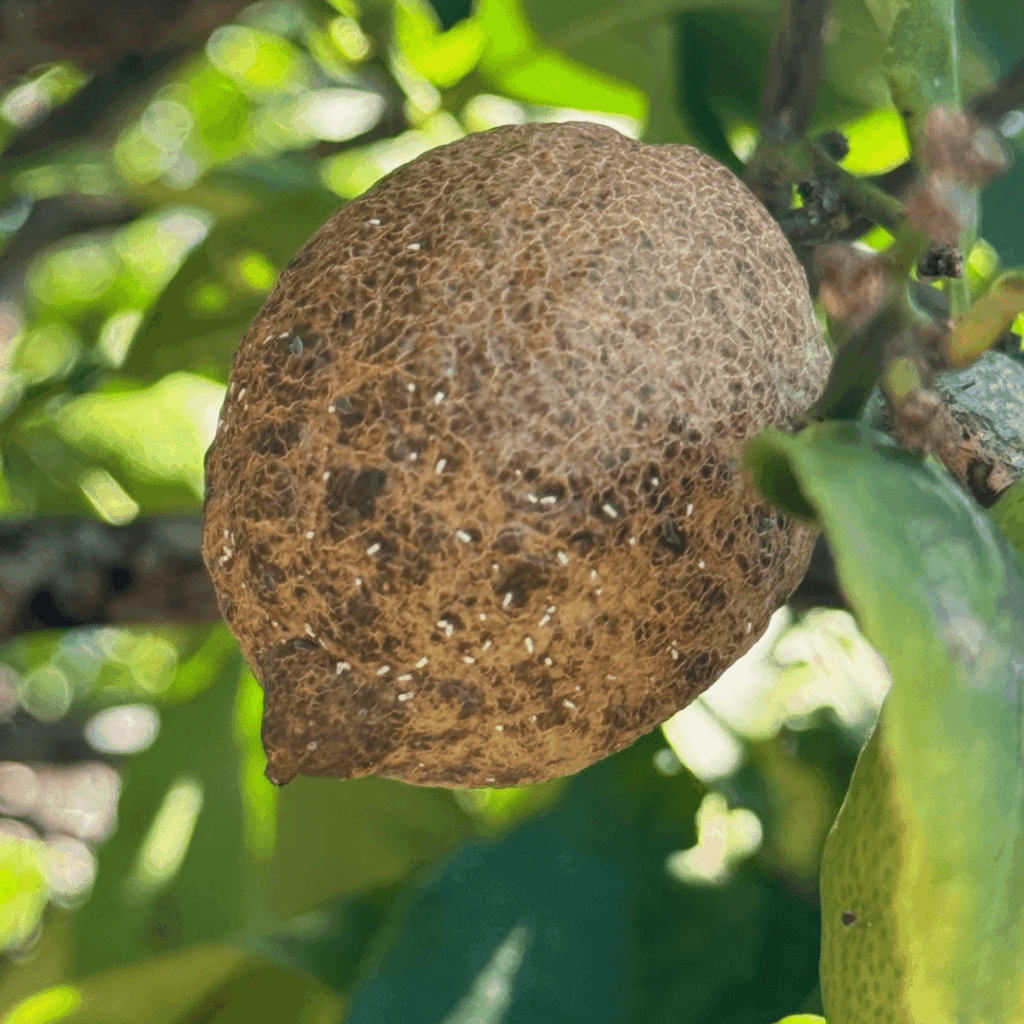
Broad Mite
What are they?
Coming soon…
What do they do?
Coming soon…
How do I fix this?!
Coming soon…

Citrus Bud Mite
What are they?
Coming soon…
What do they do?
Coming soon…
How do I fix this?!
Coming soon…


